Bockscar
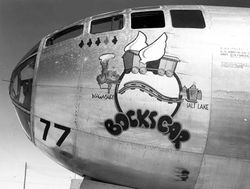
Bockscar, sometimes called Bock's Car or Bocks Car, is the name of the United States Army Air Forces B-29 bomber that dropped the "Fat Man" nuclear weapon over Nagasaki on 9 August 1945, the second atomic weapon used against Japan.
The name painted on the aircraft after the mission is a pun on "boxcar" after the name of its aircraft commander, Captain Frederick C. Bock.[1]
Contents |
Atomic bomb mission
Bockscar was flown on that day by the crew of another B-29, The Great Artiste, and was commanded by Major Charles W. Sweeney, commander of the 509th Composite Group's[2] only bomber squadron, the 393d. The plane was copiloted by Captain Charles Albury.[3] The Great Artiste, which was the assigned aircraft of the crew with whom Sweeney most often flew, was slotted in preliminary planning to drop the second bomb, but it had been fitted with observation instruments for the Hiroshima mission.[4]
Bockscar had been flown by Sweeney and crew C-15 in three test drop rehearsals of inert "Fat Man" assemblies in the eight days leading up to the second mission, including the final rehearsal the day before.[5] Rather than move the instrumentation from The Great Artiste to Bockscar, a complex and time-consuming process, the crews of The Great Artiste and Bockscar switched planes. The result was that the bomb was dropped by Bockscar, flown by the crew C-15 of The Great Artiste.[4]
There was confusion over the name of the plane because an initial eyewitness account by reporter William L. Laurence of the New York Times said that the second bomb had been dropped from The Great Artiste.[6] Laurence, who accompanied the mission as part of Bock's crew, had interviewed Sweeney and his crew in depth and was aware that they referred to their airplane as The Great Artiste. Except for Enola Gay, none of the 393rd's B-29s had yet had names painted on the noses, and unaware of the switch in aircraft, Laurence assumed victor 77 was The Great Artiste.[7]
Kokura was the primary target, but when Bockscar arrived at its rendezvous point off the coast of Japan the third aircraft of its flight (the photo ship Big Stink) was not present. After fruitlessly waiting 40 minutes, Sweeney and Bock proceeded to Kokura but found it obscured by clouds. Sweeney had orders to drop the atomic bomb visually if possible, and after three unsuccessful passes over Kokura, conferred with weaponeer Commander Frederick Ashworth (USN). They agreed to strike the secondary target, Nagasaki.[8]
A combination of factors including confusion about a malfunctioning transfer pump made fuel consumption a critical factor. Ashworth did not want to be forced to dump the bomb into the sea and decided to make a radar bombing run if necessary.[9] However, enough of an opening appeared in the cloud cover to allow Bombardier Kermit Beahan to confirm Nagasaki and the bomb was dropped, with ground zero being about 3/4 mile from the planned aiming point. This combined with Nagasaki's position on the foothills (as opposed to Hiroshima's mostly flat terrain) resulted in lower overall casualties than in Hiroshima, with much of the blast confined in the Urakami Valley.[10]
Because of the delays in the mission, the B-29 did not have sufficient fuel to reach the emergency landing field at Iwo Jima, so Major Sweeney flew the aircraft to Okinawa, where, despite being unable to make contact with the control tower, he made a safe landing with virtually empty fuel tanks.[8]
Airplane history
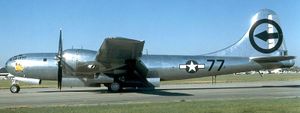
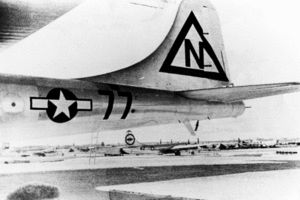
Bockscar, B-29-36-MO 44-27297, victor number 77, was assigned to the 393rd Bomb Squadron of the 509th Composite Group. One of 15 Silverplate B-29s used by the 509th on Tinian, Bockscar was built at the Glenn L. Martin Aircraft Plant at Bellevue, Nebraska at what is now Offutt Air Force Base, as a Block 35 aircraft. It was one of 10 modified as a Silverplate and re-designated "Block 36". Delivered on 19 March 1945, to the USAAF, it was assigned to Capt. Frederick C. Bock and crew C-13 and flown to Wendover Army Air Field, Utah.[11]
It left Wendover on 11 June 1945 for Tinian and arrived 16 June. It was originally given the victor number 7 but on 1 August was given the triangle N tail markings of the 444th Bomb Group as a security measure and had its victor changed to 77 to avoid misidentification with an actual 444th aircraft.[12]
Bockscar was also used in 13 training and practice missions from Tinian, and three combat missions in which it dropped pumpkin bombs on industrial targets in Japan. Bock's crew bombed Niihama and Musashino, and 1st Lt. Don Albury and crew C-15 bombed Toyama.[13]
It returned to the United States in November 1945 and served with the 509th at Roswell Army Air Field, New Mexico. It was nominally assigned to the Operation Crossroads task force but there are no records indicating that it deployed for the tests. In August 1946 it was assigned to the 4105th Base Unit at Davis-Monthan Army Air Field, Arizona, for storage.
At Davis-Monthan it was placed on display as the aircraft that bombed Nagasaki, but in the markings of The Great Artiste. In September 1946 title was passed to the Air Force Museum (now the National Museum of the United States Air Force) at Wright-Patterson Air Force Base, Ohio. The aircraft was flown to the Museum on 26 September 1961,[14] and its original markings were restored before the aircraft was put on display.[15]
Current status
Bockscar is now on permanent display at the National Museum of the United States Air Force, Dayton, Ohio. This display, a primary exhibit in the Museum's Air Power gallery, includes a replica of the "Fat Man" bomb and signage that states that it was "The aircraft that ended WWII". This is in contrast to the display of Enola Gay at the Smithsonian's Steven F. Udvar-Hazy Center, where little mention is made of that aircraft's role in WWII.
In 2005, a short documentary was made about Charles Sweeney's recollections of the Nagasaki mission aboard Bockscar, including details of the mission preparation, titled "Nagasaki: The Commander's Voice." [16]
Crewmembers
Regularly assigned crew
Crew C-13 (manned The Great Artiste on the Nagasaki mission)
- Capt Frederick C. Bock, aircraft commander
- 1st Lt Hugh C. Ferguson, co-pilot
- 1st Lt Leonard A. Godfrey, navigator
- 1st Lt Charles Levy, bombardier
- Master Sergeant Roderick F. Arnold, flight engineer
- Sgt Ralph D. Belanger, assistant flight engineer
- Sgt Ralph D. Curry, radio operator
- Sgt William C. Barney, radar operator
- Sgt Robert J. Stock, tail gunner
Nagasaki mission crew
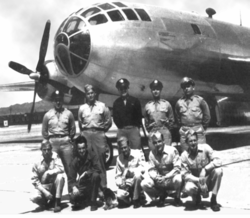
Crew C-15 (normally assigned to The Great Artiste):
- Maj Charles W. Sweeney, aircraft commander
- Capt Charles Donald Albury, co-pilot (pilot of Crew C-15) [3]
- 2nd Lt Fred Olivi, regular co-pilot
- Capt James van Pelt, navigator
- Capt Kermit Beahan, bombardier
- Master Sergeant John D. Kuharek, flight engineer
- SSgt Ray Gallagher, gunner, assistant flight engineer
- SSgt Edward Buckley, radar operator
- Sgt Abe Spitzer, radio operator
- Sgt Albert Dehart, tail gunner
Also on board were the following additional mission personnel:
- CDR Frederick L. Ashworth (USN), weaponeer
- LT Philip Barnes (USN), assistant weaponeer
- 2nd Lt Jacob Beser, radar countermeasures
National Museum of the United States Air Force display
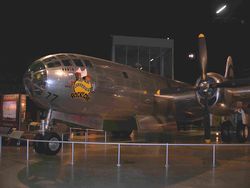 |
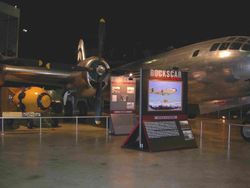 |
 |
See also
- Enola Gay
- White Light/Black Rain: The Destruction of Hiroshima and Nagasaki (2007)
References
Notes
- ↑ USAF Museum - Bockscar Story Fact Sheet
- ↑ 509th CG Aircraft Page, MPHPA
- ↑ 3.0 3.1 "Charles Donald Albury dies at 88; copilot on the Nagasaki bomb plane". Associated Press (Los Angeles Times). 2009-06-09. http://www.latimes.com/news/obituaries/la-me-charles-albury9-2009jun09,0,954488.story. Retrieved 2009-06-19.
- ↑ 4.0 4.1 "Reflections from above". University of Wisconsin–Oshkosh. http://www.uwosh.edu/faculty_staff/earns/olivi.html. Retrieved 9 May 2007.
- ↑ Richard H. Campbell (2005). The Silverplate Bombers: A History and Registry of the Enola Gay and Other B-29s Configured to Carry Atomic Bombs. McFarland & Company, Inc.. ISBN 0-7864-2139-8., 113-114.
- ↑ "Eyewitness account of atomic bombing over Nagasaki". Atomic Archive.com. http://www.atomicarchive.com/Docs/Hiroshima/Nagasaki.shtml. Retrieved 9 May 2007.
- ↑ Campbell, 222 Appendix G note 13.
- ↑ 8.0 8.1 "Timeline #3- the 509th; The Nagasaki Mission". The Atomic Heritage Foundation. http://www.mphpa.org/classic/HISTORY/H-07m1.htm. Retrieved 5 May 2007.
- ↑ "Spitzer Personal Diary Page 25 (CGP-ASPI-025)". The Atomic Heritage Foundation. http://www.mphpa.org/classic/COLLECTIONS/CG-ASPI/01/Pages/CGP-ASPI-025.htm. Retrieved 5 May 2007.
- ↑ Dennis D. Wainstock (1996). The Decision to Drop the Atomic Bomb. Praeger. pp. 92.
- ↑ Campbell, 172.
- ↑ Campbell, 19.
- ↑ Campbell, 113, 139, 142.
- ↑ United States Air Force Museum 1975, p. 16.
- ↑ Campbell, 172-173.
- ↑ Last recording of Sweeney before his death in 2004
Bibliography
- Anderton, David A. B-29 Superfortress at War. Shepperton, Surrey, UK: Ian Allan Ltd., 1978. ISBN 0-7110-0881-7.
- Birdsall, Steve. B-29 Superfortress in Action (Aircraft in Action 31). Carrolton, Texas: Squadron/Signal Publications, Inc., 1977. ISBN 0-89747-030-3.
- Birdsall, Steve. Saga of the Superfortress: The Dramatic Story of the B-29 and the Twentieth Air Force. London: Sidgewick & Jackson Limited, 1991. ISBN 0-283-98786-3.
- Birdsall, Steve. Superfortress: The Boeing B-29. Carrollton, Texas: Squadron/Signal Publications, Inc., 1980. ISBN 0-89747-104-0.
- Bowers, Peter M. Boeing B-29 Superfortress. Stillwater, Minnesota: Voyageur Press, 1999. ISBN 0-933424-79-5.
- Campbell, Richard H., The Silverplate Bombers: A History and Registry of the Enola Gay and Other B-29's Configured to Carry Atomic Bombs. McFarland & Company, Inc., 2005. ISBN 0-7864-2139-8.
- Davis, Larry. B-29 Superfortress in Action (Aircraft in Action 165). Carrolton, Texas: Squadron/Signal Publications, 1997. ISBN 0-89747-370-1.
- Dorr, Robert F. B-29 Superfortress Units in World War Two (Combat Aircraft 33). Botley, Oxford, UK: Osprey Publishing, 2002. ISBN 1-84176-285-7.
- LeMay, Curtis and Bill Yenne. Super Fortress. London: Berkley Books, 1988. ISBN 0-425-11880-0.
- Mann, Robert A. The B-29 Superfortress: A Comprehensive Registry of the Planes and Their Missions. Jefferson, North Carolina: McFarland & Company, 2004. ISBN 0-7864-1787-0.
- Marshall, Chester. Warbird History: B-29 Superfortress. Osceola,WI: Motorbooks International, 1993. ISBN 0-87938-785-8.
- Mayborn, Mitch. The Boeing B-29 Superfortress (aircraft in Profile 101). Windsor, Berkshire, UK: Profile Publications Ltd., 1971 (reprint).
- Pace, Steve. Boeing B-29 Superfortress. Ramsbury, Marlborough, Wiltshire, United Kingdom: Crowood Press, 2003. ISBN 1-86126-581-6.
- Pimlott, John. 'B-29 Superfortress. London: Bison Books Ltd., 1980. ISBN 0-89009-319-9.
- United States Air Force Museum. Wright-Patterson AFB, Ohio: Air Force Museum Foundation. 1975.
- Vander Meulen, Jacob. Building the B-29. Washington, D.C.: Smithsonian Books, 1995. ISBN 1-56098-609-3.
- Wheeler, Keith. Bombers over Japan. Virginia Beach, Virginia: Time-Life Books, 1982. ISBN 0-8094-3429-6.
External links
- Eyewitness account of atomic bombing over Nagasaki, by William Laurence, New York Times
- Reflections from above: Fred Olivi's perspective on the mission which dropped the atomic bomb on Nagasaki
- White Light/Black Rain Official Website (film)
- US Air Force Museum Archives Gallery Bockscar page with aircraft specifications
- Records of the Nagasaki Atomic Bombing